
Cymbidium, commonly known as boat orchids, is a genus of evergreen flowering plants in the orchid family Orchidaceae. Orchids in this genus are epiphytic, lithophytic, terrestrial or rarely leafless saprophytic herbs usually with pseudobulbs. There are usually between three and twelve leaves arranged in two ranks on each pseudobulb or shoot and lasting for several years. From one to a large number of flowers are arranged on an unbranched flowering stem arising from the base of the pseudobulb. The sepals and petals are all free from and similar to each other. The labellum is significantly different from the other petals and the sepals and has three lobes. There are about fifty-five species and sixteen further natural hybrids occurring in the wild from tropical and subtropical Asia to Australia. Cymbidiums are well known in horticulture and many cultivars have been developed.

Ivory is an off-white color that resembles ivory, the material which is made from the teeth and tusks of animals. It has a very slight tint of yellow.
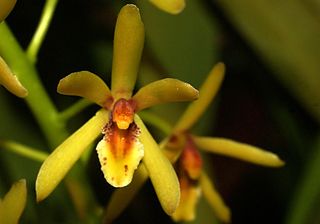
Cymbidium suave, commonly known as the snake orchid or grassy boat-lip orchid, is a plant in the orchid family and is endemic to eastern Australia. It is an epiphytic orchid that forms long-lasting clumps of grass-like leaves. Up to fifty crowded olive green to dark or brownish green flowers are borne on an arching flowering stem. Of the three Australian species of Cymbidium, this is the only one that does not have prominent pseudobulbs. It is found in eastern Australia, usually growing in the hollows of old or fallen, decaying trees.

Cymbidium mosaic virus (CymMV) is a plant pathogenic virus of the family Alphaflexiviridae.
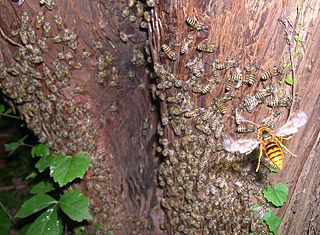
Apis cerana japonica is a subspecies of the eastern honey bee native to Japan. It is commonly known as the Japanese honey bee. This subspecies was determined, through an analysis of mitochondrial DNA, to have originally come from the Korean peninsula. They have been observed moving into urban areas in the absence of natural predators.

Cymbidium madidum, commonly known as the giant boat-lip orchid, is a plant in the orchid family and is endemic to north-eastern Australia. It is a clump-forming epiphyte or lithophyte with crowded pseudobulbs, each with between four and eight flat, strap-shaped, thin leaves and up to seventy olive green flowers with the sepals and petals curving forwards. It is found in moist habitats in eastern Queensland and north-eastern New South Wales.

Cymbidium aloifolium, the aloe-leafed cymbidium, is a species of orchid found in Asia, especially China and southeast Asia from Burma to Sumatra. It can be found growing between rocks or on another plant. The word cymbidium comes from the Greek kumbos meaning "hole, cavity" and the Latin specific name is just a translation of the English "aloe-leafed".

Cymbidium bicolor, the two-colored cymbidium, is a species of orchid found in South China to Tropical Asia.

Cymbidium canaliculatum, commonly known as the channelled boat-lip orchid, tiger boat-lip orchid, native cymbidium or tiger orchid is a plant in the orchid family and is endemic to Australia. It is a clump-forming epiphyte with large, greyish green pseudobulbs, each with up to six curved, deeply channelled leaves and up to sixty fragrant, variably coloured flowers that often have spots and blotches and a white to cream-coloured labellum with red markings. This orchid usually grows in the forks or hollows of trees and is found from New South Wales to the northern parts of Western Australia.

Cymbidium eburneum, the ivory-colored cymbidium, is a species of orchid.
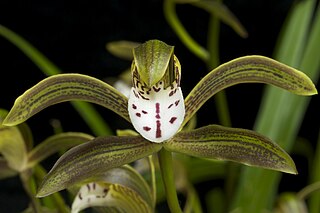
Cymbidium erythraeum, the Indian cymbidium, is a species of orchid.
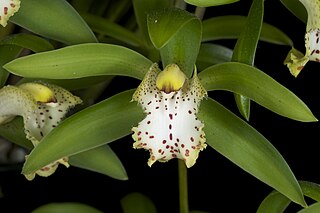
Cymbidium hookerianum is a species of orchid found in India, China, and Vietnam. It is distributed widely in Bhutan, especially in the cool temperate forests.

Cymbidium kanran, the cold-growing cymbidium, is a species of orchid.
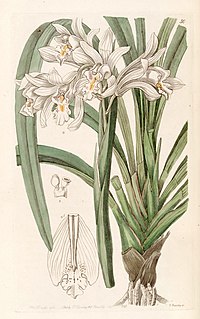
Cymbidium mastersii, the Master's cymbidium, is a species of orchid.

Cymbidium elegans, the elegant cymbidium, is an orchid species in the genus Cymbidium found in South West China.
Cymbidium is a brachiopod genus in the order Pentamerida from Silurian Alaska, from the Cape Phillips Formation from Baillie-Hamilton Island, Arctic Canada and Malaya.

The Imperial Seal of the Emperor of Manchukuo had a design of orchid flower, with five Sorghum branches in between the five orchid petals. It was entirely yellow.

Cymbidium lowianum, called Low's boat orchid, is a species of orchid in the genus Cymbidium, native to Assam in India, Yunnan in China, Myanmar, Thailand, and Vietnam. It has gained the Royal Horticultural Society's Award of Garden Merit.
This page is based on this
Wikipedia article Text is available under the
CC BY-SA 4.0 license; additional terms may apply.
Images, videos and audio are available under their respective licenses.

![]() Media related to Cymbidium chloranthum at Wikimedia Commons
Media related to Cymbidium chloranthum at Wikimedia Commons















